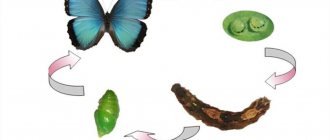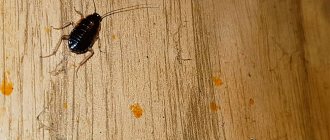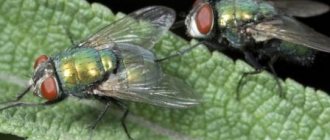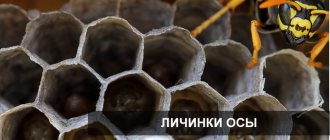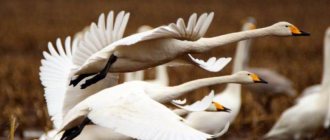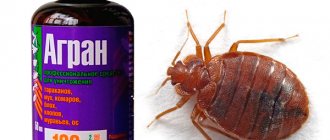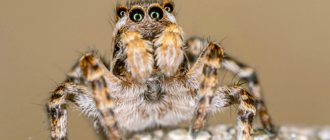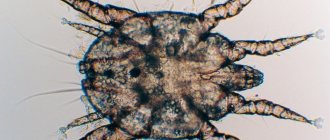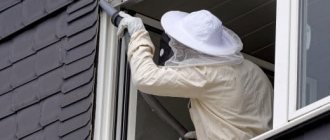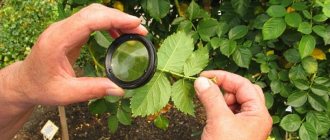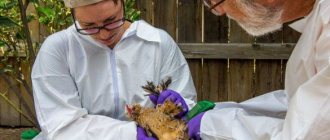Home » Interesting collections about animals
People are often afraid of insects or wary of them. Indeed, among the numerous insects there are pests and disease carriers. But there are many more harmless species; there are even useful ones that serve as irreplaceable helpers for people.
- 2 Ground beetle
- 3 Trichogramma
- 4 Lacewing
- 5 Ant
- 6 Bee
- 7 Medvedka
- 8 Silkworm
- 9 Cochineal
- 10 Lacquer bug
Ladybug
Ladybugs help in the fight against garden and vegetable pests; the most common in Russia are the seven-spotted ones. An adult insect eats 100–200 aphids and spider mites per day.
Ladybugs can be attracted by planting plants from the Asteraceae family, such as daisies, tansy or yarrow.
Ladybugs are very fertile; during their life, which lasts about one and a half years, one female lays up to 1 thousand eggs. The larvae that hatch from them are even more beneficial than the adults. During the development period, such a baby eats up to 3 thousand pests.
Ladybug larvae are sometimes mistaken for pests and destroyed
Garden ant queen
In the photo: Ants mating
It's hard to imagine, but females of common garden ants can live up to 20 years! Have you probably seen ants with wings? It turns out that these are young females and males of ants who leave their anthill to mate during the mating season.
Females are larger, males are smaller. The male’s task is to transfer his genetic material to the female, which she will keep for the rest of her life. After fertilization, females shed their wings and establish new colonies, while males self-destruct.
Ground beetle
Nocturnal predators that feed on other insects are of great benefit in a summer cottage. Ground beetles destroy harmful creatures - a variety of beetles, larvae, pupae and caterpillars. Even slugs and snails feed the garden nurses. In one season, a pair of ground beetles can destroy several thousand pests.
In one night, in search of food, a ground beetle can cover a distance of several kilometers.
Unfortunately, these beetles are sometimes considered pests and are destroyed. There are several species of ground beetles that are dangerous to plants, but they can be distinguished. You need to pay attention to the legs and jaws. Harmful ground beetles are stockier, with short legs and not very protruding jaws. The useful ones are large, lean, with long legs and well-developed jaw apparatus.
Flying arthropods
Some insects fly through open windows and doors and settle in the house for a long time. They can be seen with the naked eye and a fairly loud buzzing sound can be heard.
Flies . According to recent research, most flies sleep at night and doze during the day. The fly has a complex eye structure. It consists of thousands of lenses, which gives her the ability to see in many directions at the same time. Sensitive villi on the fly's body allow it to hear sound vibrations. Their taste buds are on their paws. When choosing food, flies moisten it with saliva and absorb it. Then they burp it to soften it, and then suck it up with a sponge-like mouth. They eat constantly, as well as mate. Flies live for about three weeks.
Wasps . They often make their nests in people's homes. Usually these are attics, balconies, loggias, verandas. They build nests from chewed wood and fiber. Wasps often drink water as well as sweat from people's skin. Every year about 1.5 thousand people die from their bites. But nevertheless, they provide benefits by eating other insects.
Moths are a well-known household pest, a lepidopteran insect. Moth larvae eat not only fabric, but also products of plant origin: grains of wheat, corn, barley, oats, and also eat flour and even dry bread. Moths are known to enter the home when attracted to bright light. And when they get into a home, they settle in it forever.
Trichogramma
Not everyone knows about such an insect as Trichogramma. But this miniature creature brings invaluable benefits - it fights representatives of more than 70 species of pests. Moreover, it destroys not adult individuals, but eggs - Trichogramma lays larvae in them, which, as they develop, destroy the contents. In one season, a female can lay 500–800 eggs.
Trichogramma is an egg-eater from the order Hymenoptera, the smallest insect measuring 0.4 - 0.9 mm
The ability to eradicate pests on a large scale makes Trichogramma an alternative to chemical insecticides. It is even bred on an industrial scale and sold to gardeners.
Different in socialization
All insects are conventionally divided into two categories: solitary and social. According to the names, they either live on their own and interact only in the case of reproduction, or they exist in a colony, family, or clusters.
Social insects
This includes those who live in an organized family and their own hierarchy. These species have a structure and their own occupation for each family member.
Paper wasps. This species has a nest that is built by workers, a queen that is responsible for reproduction, and animals that feed the offspring.
Termites. They build homes and live in colonies, feed on wood and pose no danger other than possible destruction.
Solitary insects
Those that do not live in colonies or families. They prefer to live alone and not meet others like themselves unless necessary.
Earwigs
After mating, the mother carefully arranges a place of residence and remains there until the babies are able to set out on an independent life. They don't touch anymore.
Scorpion
This arachnid is a prime example of loners. They only meet other representatives of the species when mating is necessary. And even then, the male may suffer.
Lacewing
Attractive pale green insects prey on aphids and mites. Lacewings were the first to be specially bred to protect greenhouse plants from pests.
In summer, lacewings often fly into apartments - at night they are attracted to electric light
If you touch an insect, an unpleasant odor will appear. But lacewings are harmless to humans.
Order Coleoptera
Aphodius bimaculatus
)
Brachycerus sinuatus
)
Smooth bronzeweed ( Protaetia aeruginosa
)
Tooth-breasted woodcutter ( Rhaesus serricollis
)
Relict woodcutter ( Callipogon relictus
)
Avinova's ground beetle ( Carabus avinovi
)
Hungarian ground beetle ( Carabus hungaricus
)
Gebler's ground beetle ( Carabus gebleri
)
Caucasian ground beetle ( Carabus caucasicus
)
Lopatin's ground beetle ( Carabus lopatini
)
Menetries ground beetle ( Carabus menetriesi
)
Wrinkled-winged ground beetle ( Carabus rugipennis
)
Narrow-breasted ground beetle ( Carabus constricticollis
)
Stag beetle ( Lucanus cervus
)
Maksimowicz's krasotel ( Calosoma maximowiczi
)
Sweet beetle ( Calosoma sycophanta
)
Calosoma reticulatus
)
Uriankhai leaf beetle ( Chrysolina urjanchaica
)
Omias verruca
)
Common hermit ( Osmoderma eremita
)
Black staghorn ( Ceruchus lignarius
)
Wrinkled mower ( Otiorhynchus rugosus
)
Common Elephant ( Euidosomus acuminatus)
)
Stephanocleonus tetragrammus
)
Alpine longhorned beetle ( Rosalia alpina
)
Parrey's snapper ( Calais parreysii)
)
Ant
It’s not for nothing that forest ants are called little workers - they protect plants from caterpillars and larvae, slugs, spider mites and other insects. The inhabitants of one anthill control an area of about 0.2 hectares. Also, thanks to the activity of ants, the content of potassium and phosphorus in the soil increases.
It is worth monitoring the number of ants, because they can contribute to the proliferation of aphids
These insects are also used to make medicine. Formic acid is used as a stimulant and astringent. Some are even treated with ant bites. But here you need to be careful, because the individual reaction of the body can be negative.
Order Lepidoptera
Alcinous ( Atrophaneura alcinous
)
Common Apollo ( Parnassius apollo
)
Arcte blue ( Arcte coerula
)
Asteropetes noctuina
)
Bibasis aquilina
)
Dark bluewort ( Parocneria furva
)
Oreas blueberry ( Neolycaena oreas
)
Excellent marshmallow ( Protantigius superans
)
Pacific marshmallow ( Goldia pacifica
)
Clanis undulosa
)
Lucina ( Hamearis lucina
)
Mnemosyne ( Parnassius mnemosyne
)
Seokia eximia
)
Sericinus montela
)
Sphecodina caudata
)
Wild mulberry silkworm ( Bombyx mandarina
)
Erebia kindermanni
)
Bee
The importance of bees can hardly be overestimated, because these hardworking insects pollinate plants and produce honey, which is used in cooking, for cosmetic purposes, and for the treatment of diseases. And other beekeeping products - bee bread, propolis, royal jelly, bee venom - are no less useful. All of them are natural antibiotics.
Pollination of plants by bees improves the quality of seeds, increases the size, juiciness and taste of fruits
Even beehives and dead insects are beneficial. Wax is made from honeycombs, and medicinal tinctures are made from bee pestilence.
Order Hymenoptera
Abia Pribaikalskaya ( Abia semenoviana
)
Yellow-headed acantholyda ( Acantholyda flaviceps
)
Liometopum orientale
)
Orussus abietinus
)
Parnopes grandior
)
Wax bee ( Apis cerana
)
Common carpenter bee ( Xylocopa valga
)
Caenolyda reticulata
)
Armenian bumblebee ( Bombus armeniacus
)
Steppe bumblebee ( Bombus fragrans
)
Medvedka
Mole crickets are usually considered malicious pests, because they gnaw the roots of plants while burrowing in the ground. Although some see the benefit of the insect, since it is partly a predator and can eat creatures that are no less dangerous to the flora, such as the larvae of the cockchafer.
For treatment, the mole cricket is caught in environmentally friendly places; insects that come into contact with chemicals will be toxic
Medvedka made it to the top because of its healing properties. In China, for a long time, it has been used to treat various diseases, including severe ones - tuberculosis, cirrhosis, diabetes.
Woodlice in the budinka are not quite mosquitoes
And the woodlice axis (as was already guessed in the cob itself) can not be brought to the coma, but it is impossible to live in a booth - and arthropods are raised to the class of great crayfish.
This photo shows the zvichaina armadillo (Latin name Armadillidium vulgare):
And here is the short woodlice, the most common guest in the booths:
Particularly harmful human stench, for example, does not smell like typical bedbug parasites: occasionally woodlice pester the reserves of vegetables or (as soon as you can get there) harm the young parts of indoor plants. Tim is no less, the sustrich with these miniature spivmeshkans will never be accepted.
As a rule, wood lice appear in areas where there is high humidity or water flow: this includes bathrooms and toilets. There is also a quiet dark corner (woodlice, like targans, do not like bright light), and hedgehogs - for example, a mixing bowl in which you can eat various organic surpluses.
In this and other worlds, woodlice are associated with water (even though they smell like crustaceans), so it’s easy to get rid of them.
In most cases, it is necessary to turn off the vital necessity for them: dry the bathtub or, for example, fix the leak in the tap. If you go for any reason not to bring the desired effect, then you can get rid of woodlice using any current insecticidal agent (Get, Delta-Zona, Tsifoks, Dobrokhim FOS et al).
Silkworm
We have silkworms to thank for the silk items in our wardrobes. The caterpillars of these butterflies produce silk. More precisely, silk fiber from which the insect builds its cocoon. One larva is capable of producing 15 cm of mulberry in a minute. And in the cocoon of this thread there can be about a kilometer.
The silkworm is unknown in the wild; it was domesticated several thousand years ago in China.
Other types of silkworms are sometimes bred, but they produce fiber of poorer quality.
Carpet beetle
There are beetles that, on the contrary, help humans and serve science well. They clean the bones of exhibits in museums, from the remains of tendons and muscles. They do this work much better than a person and completely free of charge, without expecting anything in return.
What does the world look like through the eyes of insects?
People and insects see everything that happens completely differently. Insects have very unusual and complex eyes. The shimmering surface of their eyes looks like a mosaic, each eye consisting of separate, motionless ocelli, each of which sees a limited picture. In some animal species, the eye consists of 30,000 elements.
Ants are much less lucky in this regard, since they mostly have underdeveloped eyes, and many are even blind.
In their eyes, the world is like an enlarged mosaic picture, made up of individual pieces. They practically cannot distinguish the appearance and shape of objects, but they can see movement perfectly. Many ants have additional eyes on their heads that react to light.
The most convenient option is flies and dragonflies. Their eyes are located on most of their heads, allowing them to have a perfect 360-degree view, allowing them to see danger above, below, and even behind.
How long do insects live?
On average, insects live less than a year, and some can live a little longer.
A housefly can live from 10 to 30 days, and larger mosquitoes can live from 10 days to 2 months. It is possible that mosquitoes live longer thanks to daily and nutritious nutrition, so if you do not want a mosquito to haunt you for 2 months, protect your skin, wear more covered clothing and try to cover your head in warm weather.
But in winter, flies, mosquitoes or larvae can fall into an inactive state, in which they can survive several months of cold weather.
Among insects there are also long-livers:
Cochineal
Several species of insects from which the red dye carmine is made are collectively called cochineal. Carminic acid, which is the main component of paint, is extracted from female cochineal scale insects.
Ararat, oak, Mexican and Polish cochineal are combined under the general name cochineal.
Dyes from these insects were obtained back in the 6th century BC.
